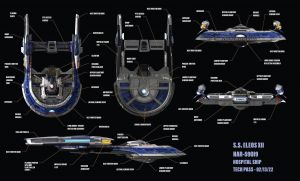Phoenix Class
| STARSHIP | |
|---|---|
 | |
 | |
| Class | Phoenix Class Corvette |
| Allegiance | United Federation of Planets |
| Status | Active |
| Specifications | |
| Type: | Corvette (CR) |
| Length: | 119 Meters |
| Beam: | 45.6 Meters |
| Height: | 17.1 Meters |
| Mass: | 88,750 metric tons |
| Decks: | 4 Deck Plans |
| Crew Compliment: | Standard: 10 Officers and Enlisted Crew Breakdown Emergency: 100 |
| Warp Speed: | Type: Thrawn-class Warp Core Reactor with two LF-33 nacelles Cruise Speed: Warp 7 Sustainable Speed: Warp 8 Emergency Speed: Warp 9 (12 hour automatic shutdown) |
| Impulse Engines: | Type: 2 FIG-5B Main Impulse Engines Speed: .9 C |
| Defensive Systems: | Type-2A Shield generator |
| Armament: | Phasers: 360-degree Type-I Array (Dorsal); 1x Twin 360-degree Type-I Array (Ventral); |
| Computer System: | Yori-Moto D4D019 |
| Tractor/Repulsor: | 1 Main Tractor/Repulsor Beam, 2 Docking Tractors |
| Sensors: | Daystrom Industries HSCS-2SC-B Starship Sensors |
| Other Systems: | Planetary Landing Capability - Blue Alert |
Overview
Initially entering trial production in 2352, the Phoenix-class was designed to facilitate a rapid response in auxiliary tasks; being able to quickly transport supplies and components, or transfer, in a limited way, personnel within the borders of the Federation in the Alpha and Beta Quadrants. While the Danube-class Runabouts initially proved to be more tactically adept, the Phoenix-class is still significantly faster, with greater range and payload capacity. More modern designs have seen use as police ships operated by Starfleet Security, or as convoy escorts operated by Logistics and Transport Command.
The development of the project fell to the Skywalker Division of Starfleet's Marin County shipyard, which had experience in small ships, such as the Oberth-class and Raven-type. These emphasized the requirement to focus the new platform on achieving high speeds. Prioritizing design efficiency over comfort or aesthetics, the result was a small ship with a semicircular hull, from which two pylons emerge towards the stern to support the nacelles.
As well as being common in Starfleet, the Phoenix-class has done well on the civilian market, with several ex-Starfleet Medical vessels serving with groups such as the Mariposa Medical Group.
Capabilities
In order to increase the power of the reactor, which, due to space issues, had certain limitations, a warp field regulator inspired by the NX class was implemented; the module was installed between the curvature nacelles, and regulated the shape of the warp field that would otherwise break down upon reaching higher warp factors. In early versions of the propulsion system, the Phoenix class achieved a maximum speed of factor 6.0 and a cruising speed of 4.6. Although with the different system updates, this increased to a factor of 8.7 at maximum speed and a sustained factor of 7.2.
Four impulse engines, two powerful and compact subatomic units installed in the stern of the main hull and two other smaller auxiliaries, placed at the end of the arms that supported the nacelles, gives the Phoenix-class greater sublight acceleration and maneuverability than other ships of similar size, and is an advantage against larger ships with a lower power to mass ratio.
Despite its size, it was equipped with numerous sensors; providing it with greater tracking and analysis capacity than other ships of its size. This allowed the Phoenix class to operate as a mobile lab, or as a short-range scout or reconnaissance vessel, thus freeing up other designs such as the Nova Class for other duties.
Mission Profiles
From the first phases of development of the Phoenix-class it was clear that these ships had an operational profile far from exploration, but rather that they were going to be used in auxiliary missions for the different branches of Starfleet.
Starfleet Medical would initially commission the Phoenix-class for the delivery of medical supplies, engineering components or limited transfer of personnel. In initial plans, even cargo holds could be transformed into limited laboratories or intensive care rooms. Eventually specific modules were built for this, allowing their rapid exchange for emergency situations. As these modules were perfected and integrated, Starfleet Medical began using the Phoenix-class as "Ambulance Ships" or mobile trauma units, supplementing Starfleet Medical's fleet of Hospital Ships.
The Starfleet Corps of Engineers would dedicate their Phoenixes to transporting repair teams to damaged or damaged ships in deep space, starbases, outposts, or those facilities that did not have the necessary personnel or material. As well as they are responsible for the regular maintenance of subspace communications stations. These ships usually embarked Workbees or a Sphinx Workpod for deep space repair operations.
After the destruction of Romulus, Starfleet Command would commission several dozen Phoenix-class ships to act as convoy escorts or short range patrol craft around the former Romulan Neutral Zone; these ships were often upgraded with extra weapons, though the increased power demands limited their operational range and overall utility. Many such conversions were later returned to standard and either assigned to Starfleet Medical, the Corps of Engineers, or as fast transports for Logistics and Support Command.
Vessels of Note
- SS Clementia IV, NAR-59037 - Medical Ship
- SS Eleos XII, NAR-59019 - Medical Ship (Destroyed, 2401)
- USS Fortuna, NCC-63189
- USS Geronimo, NCC-75250
